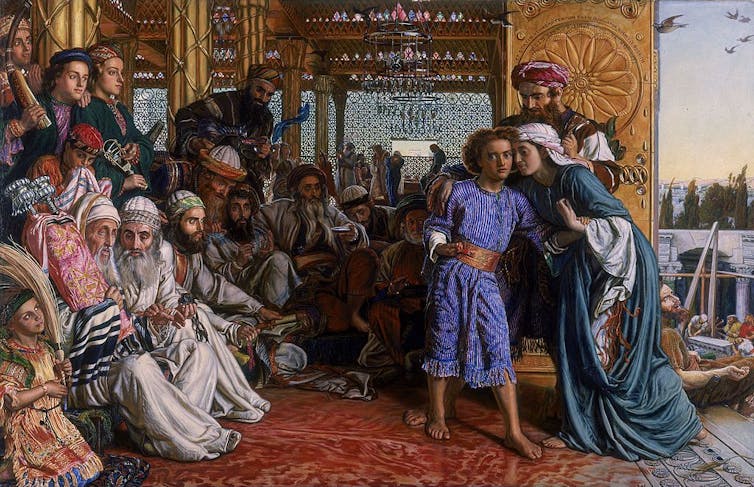How parenthood has changed the way I read ancient childhood stories about Jesus, Mary and Joseph
Family is not a clearly defined structure in the story: It isn’t biological or reflective of some 'norm.' It is instead a choice to stick together, come what may.

As Christmas approaches, many Christians will reflect on the Nativity, or birth of Jesus. The Christian Bible includes two different stories of the birth of Jesus, found in the Gospel of Matthew and the Gospel of Luke. But there are precious few details about the rest of his childhood in the New Testament.
Some Christians today may wonder, what happened next?
The Infancy Gospel of Thomas
I write about this question in my book, “Jesus, Mary, and Joseph: Family Trouble in the Infancy Gospels.” The Infancy Gospel of Thomas, a key source for my book, describes the childhood of Jesus. It is “extracanonical,” meaning that it cannot be found in copies of the Bible belonging to the main branches of Christianity.
It is not a source for the historical Jesus. What it reveals instead is the early Christian imagination. It was read widely by ancient Christians, who copied the stories and translated them into a number of different languages: Greek, Latin, Syriac, Arabic, to name a few.
The Infancy Gospel of Thomas includes stories about the child Jesus between the ages of five and 12. The contents of this gospel might trouble many modern-day Christians, who picture Jesus, even in childhood, as a perfect being.
While the child Jesus performs blessings, healing his brother, James, for example, from a snakebite, he also gets into trouble. Jesus curses and hurts other children. He gets a bad reputation. When a playmate named Zeno falls from a roof and dies, his parents accuse Jesus of pushing Zeno from the roof. But Jesus brings the dead boy back to life. The parents of Zeno praise God and the young savior.
Jesus, age 12
If readers are confused by the behavior of the child Jesus in the Infancy Gospel of Thomas, they are in the same position as his parents. Mary and Joseph don’t understand him.
The final episode of the Infancy Gospel of Thomas is an echo of the single childhood story about Jesus in the New Testament. In the Gospel of Luke, the holy family nearly splits up. Jesus, 12 years old at the time, goes with his parents to Jerusalem to celebrate Passover. Afterwards, Mary and Joseph head back home. But not Jesus.

He stays in Jerusalem without permission. Traveling home, Mary and Joseph suddenly realize that Jesus is missing. Three days into the search they find the child in the temple in Jerusalem, teaching the grownups. Mary scolds Jesus for upsetting them,
“Child, why have you treated us like this? Look, your father and I have been searching for you in great anxiety.”
Jesus replies,
“Why were you searching for me? Did you not know that I must be in my Father’s house?”
Jesus shrugs off Mary’s worry and all but ignores Joseph, speaking instead of his divine father. His words leave Mary and Joseph at a loss as they do not understand what he said to them.
Far from the tree

I suspect that Mary and Joseph’s failure to understand Jesus is the element that will resonate most strongly with modern readers. It reminds me of Andrew Solomon’s powerful book, “Far From the Tree: Parents, Children, and the Search for Identity,” which describes parents and children who seem to be separated by profound differences.
In one chapter Solomon describes the experiences of parents of deaf children. In another, he portrays the challenges faced by families with children born with Down syndrome. What Solomon uncovers through these case studies is “the profound unknowability of even the most intimate human relationship.”
Yet, as Solomon observes, differences can strengthen rather than weaken bonds. Differences that push us to the limits of understanding can nevertheless teach us how to love.
Solomon’s chapter on Down syndrome hits close to home. I am the father of two children, one who was born with Down syndrome and one who was born without an extra chromosome. On rare days the stars align, and I know exactly what to say or do as a parent. Most of the time I am uncertain. Sometimes, I am deeply confused. Yet, like Andrew Solomon, I think love is built from all of these moments.
Perhaps a similar message can be found in the story of the 12-year-old Jesus. Is he “far from the tree”? Uncertain after the scene in Jerusalem, Mary, Joseph and Jesus return home together. Family is not a clearly defined structure in the story: It isn’t biologically based or reflective of some “norm.” It is instead a choice to stick together, come what may.
This Christmas, stories about the baby Jesus will get most of the attention. But spare a thought for the tween-age Jesus and his confused parents. They don’t always understand him.
They love him anyway.
Christopher A. Frilingos does not work for, consult, own shares in or receive funding from any company or organization that would benefit from this article, and has disclosed no relevant affiliations beyond their academic appointment.
Read These Next
2 superpowers, 1 playbook: Why Chinese and US bureaucrats think and act alike
The men and women tasked with implementing policy are governed by the same incentives and constraints…
Gazing into the mind’s eye with mice – how neuroscientists are seeing human vision more clearly
It was once believed that mice had relatively poor vision. Turns out mice are far from blind – and…
Epstein’s victims deserve more attention than his ‘client list’
Powerful men connected to Jeffrey Epstein are named, dissected and speculated about. The survivors,…






